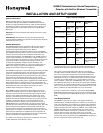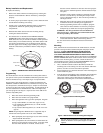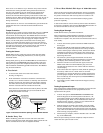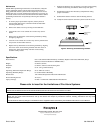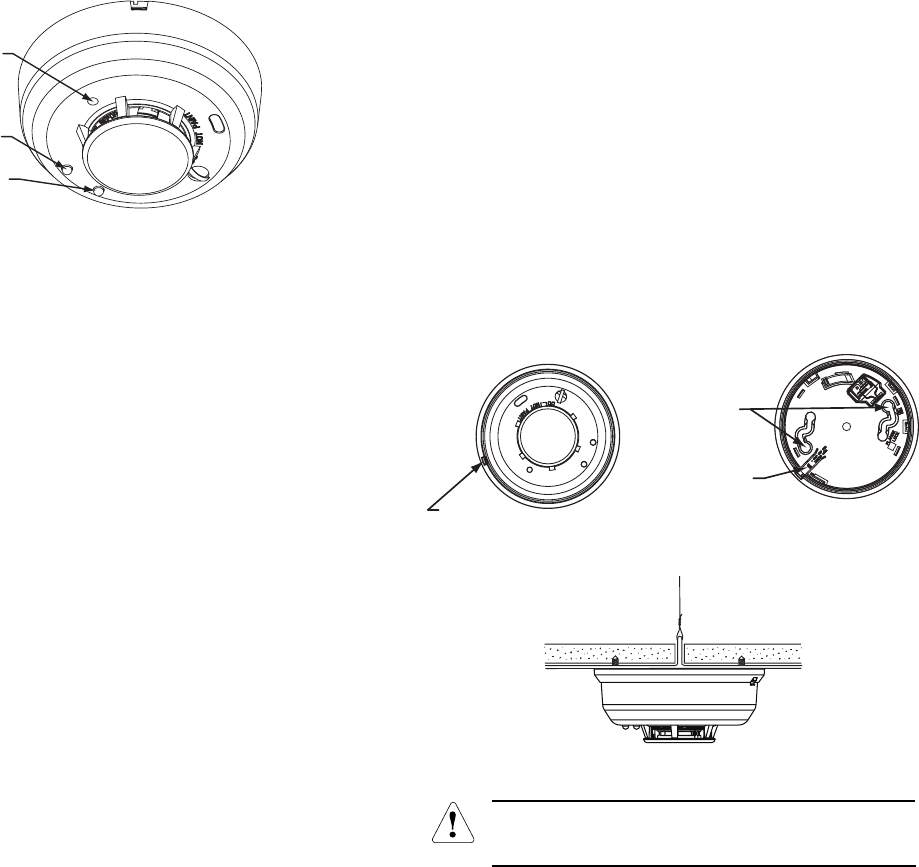
- 2 -
Battery Installation and Replacement
To replace the battery:
1. Remove the detector from its mounting base by twisting the
detector counterclockwise. Remove the battery, and dispose
properly.
2. To ensure proper power-down sequence, wait a minimum of 20
seconds before installing new battery.
3. Install a new 3-volt CR123A Lithium battery in the battery
compartment. Follow the polarity diagram inside the
compartment.
4. Reinstall the smoke detector onto the mounting base by
turning the detector clockwise.
5. Test the detector as described in the TESTING SIGNAL
STRENGTH section of this manual. The green LED should
blink about once every 10 seconds to indicate normal operation.
If the battery is not installed correctly, the smoke detector will
not operate and the battery may be damaged. If the detector
does not appear to be sending a signal during any of the tests,
check for correct battery installation and for a fully charged
battery.
Test Switch
Green LED
Red LED
Figure 1. 5808W3 Wireless Smoke/Heat Detector
Programming
The smoke detector must be enrolled in the control panel before it
can operate in the system. The 5808W3 smoke/heat protection zone
must be enrolled as Loop 1 and “Input Type” 3 (supervised RF).
If programmed, this smoke detector is capable of monitoring the
additional conditions of Maintenance (transmitted as Loop 2), and
Low Temperature (transmitted as Loop 3). Tamper is transmitted
as Loop 4, but does not require programming. To take advantage of
the value added features of Maintenance and Low Temperature,
you must program each loop as a separate zone in the 5800 series
wireless compatible panel.
1. Enter the control’s Zone Programming mode.
2. Enter the zone number to be programmed.
3. Enter the applicable zone type when prompted. Program
• Loop 1 (Heat/Smoke) as a Fire zone (type 9 or 16),
• Loop 2 (High/Low Maintenance) as a 24-Hr. Trouble
zone (type 19), and
• Loop 3 (Freeze Warning Sensor) as a 24-Hr. Aux. zone
(type 8).
NOTE: Loop 2 High/Low Maintenance is supported only on
commercial control panels such as the Vista-128FBP.
4. When prompted, enter Input Type 03 (3 on some controls)
– Supervised RF Transmitter.
5. When prompted for the serial number, transmit from the
detector by activating the tamper switch. To do this, hold
the base of the detector in one hand, and rotate the
detector counter-clockwise on the base until it snaps open.
Then return to clockwise position until the detector snaps
into place.
6. When the serial number is displayed, transmit from the
detector a second time by activating the tamper switch
again as described in Step 5. The current loop number (4)
will begin to flash.
7. Manually change the loop number to the desired loop
number for the zone (according to the application).
8. When programming for this zone is complete, program
other zones for the transmitter as necessary (except for
Tamper Loop 4, which does not require programming).
WARNING: The fire protection zone enrolled must
always be Loop 1. Otherwise, fire annunciations will
not be reported by the control.
9. Exit Programming mode when programming is complete,
and test the detector. Refer to the Testing Section.
See the control unit’s installation instructions for further
details.
Mounting
First, determine the best location for the smoke detector, one that
provides a strong wireless transmission path and proper smoke
detection. A GOOD TRANSMISSION PATH MUST BE
ESTABLISHED FROM THE PROPOSED MOUNTING
LOCATION BEFORE PERMANENTLY INSTALLING THE
DETECTOR. To check, perform the test described in the TESTING
SIGNAL STRENGTH section of this manual. Prior to mounting the
detector to the mounting base, you must “enroll” the detector’s
serial number into the system (see the PROGRAMMING section).
To mount the detector, perform the following steps:
1. Once a suitable location has been determined, install the
mounting base on the ceiling or on the wall (if local ordinances
permit). Use the two screws and anchors provided.
2. Turn the detector in a clockwise direction in the mounting base
until it clicks into place.
3. Test the detector immediately after completing the installation
(as described in the TESTING section of this manual) and
refer to the control system’s instructions for additional
information concerning the use of wireless smoke detectors.
Tamper
Release Tab
Direct Mount Holes
Tamper Resistant Tab
(Cut off small tab to activate
tamper resist feature)
Figure 2. Detector Mounting Base
Figure 3. Mount Detector Across Ceiling Panel Support
DO NOT attach the detector to removable ceiling panels.
Attach the detector across panel support as shown in
Figure 3.



